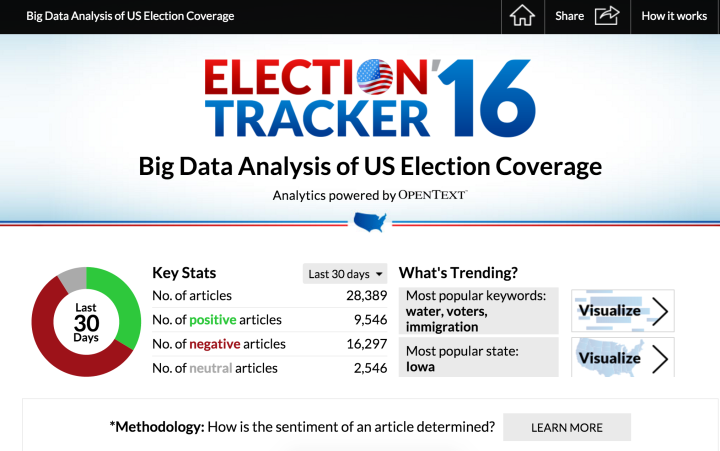
When it comes to bombastic elections, 2016 is quickly making its way to the all-star list. Reading more like a reality show than a serious exercise in democracy, one of the biggest culprits in the horse race that is every presidential election would appear to be our dear friend, the media. Love it, hate it, but you can’t live without it, and politicians have wasted no time in painting the biggest target of the year on the backs of news outlets on both sides of the fence. But what is the media really writing about when it comes to the election? As it turns out, the Analytics Election Tracker 2016 from OpenText has all the answers.
In order to create its highly interactive dashboards that summarize and compare election coverage across outlets, the Analytics Election Tracker examines text from thousands of online news articles and global media outlets, and ultimately is able to summarize key aspects about the resulting attention — what are the hot topics? Who are the top candidates? How and why are they being discussed? All questions that have meaningful answers, thanks to the new Web app.
While other trackers poll public sentiment, OpenText’s tracker relies solely on news articles to serve as “unstructured data,” revealing “trends across topics, history, geography, [and] sentiment.”
Some of the results have been more predictable than others — for example, data reveals that since August 30, 2015 Donald Trump has received more than twice as many mentions in the media as Ted Cruz. But then, there are also some less obvious trends that reveal just where the American mindset lies as we enter primary season in earnest. According to the Tracker, the most popular U.S. election keywords in the media have been “refugee, gun, and tax,” while the least commonly mentioned topics include the environment, economy, and healthcare.
“Analyzing both structured and unstructured data provides a full picture of any situation to enable smarter, data-driven business decisions,” said Adam Howatson, chief marketing officer at OpenText. “OpenText technology actually analyzes the content of the unstructured data, much in the way a human would, only much faster and with a perfect memory and better aggregate insight over massive volumes. Election Tracker ’16 is a working example of unstructured data analysis in action and showcases its ability to provide a solution to an increasingly common business concern across all industries.”
So if you want to see just how many of the articles about the 2016 election have been negative, or which outlets are covering the election the most neutrally, head on over to the Analytics Election Tracker 2016, and let big data tell its story.
Editors' Recommendations
- What does a check mark mean on Facebook Messenger?
- YouTube is rolling out handles. Here’s what you need to know
- What is Section 230? Inside the legislation protecting social media
- Here’s what a neuroscientist really thinks about Elon Musk’s Neuralink
- Trump plans executive order targeting social media after Twitter fact-check spat


